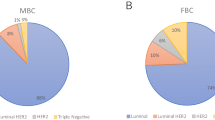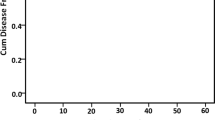Abstract
Objective
The extremely low incidence of male breast cancer (MBC) leads to lack of prospective randomized phase III studies worldwide. Especially in China, all studies on Chinese patients with MBC were based on small sample size and single institute experience. The aim of this study was to provide overall view of characteristics of Chinese patients with MBC by means of summarizing all related papers published in Chinese journals.
Methods
An online search was made in CBM, VIP, CNKI, and CBA databases to find all published articles of interest on Chinese patients with MBC. And eight subjects including the proportion of MBC in all breast cancer, age, tumor location, clinical stages, pathological subtypes, treatment modalities, ER/PR expression, and 5-year survival rate were selected to calculate the proportion and their 95% interval confidence.
Results
There were 122 papers with 2584 patients enrolled. The basic features of Chinese patients with MBC included: (1) MBC only with a proportion of 1.06% of all the breast cancer; (2) The mean age at diagnosis was 57.6 years old; (3) Tumor mainly located in the areolar region (74.83%) with obvious nipple and/or skin involvement; (4) Nearly 62.62% patients were in early stage before accepting treatment; (5) Infiltrating ductal carcinoma accounted for 79.05% of all pathological subtypes; (6) ER/PR expression rate was 65.86%; (7) Radical resection was up to 86.06% in all surgical modalities; (8) The 5-year survival rate was 57.33%.
Conclusion
The results showed in this study were an overall view of Chinese patients with MBC whose characteristics were similar to that reported in the West. Though this study provided a little bit stronger confidence than a single study collected in this paper, studies with more powerful evidence are urgently demanding in China.
Similar content being viewed by others
References
Contractor KB, Kaur K, Rodrigues GS, et al. Male breast cancer: is the scenario changing. World J Surg Oncol, 2008, 6: 58.
Jemal A, Siegel R, Ward E, et al. Cancer statistics, 2006. CA Cancer J Clin, 2006, 56: 106–130.
Yang MT, Rong TH, Huang ZF, et al. Clinical analysis of respectable breast cancer: a report of 6263 cases. Chin J Cancer (Chinese), 2005, 24: 327–331.
Wernberg JA, Yap J, Murekeyisoni C, et al. Multiple primary tumors in men with breast cancer diagnoses: a SEER database review. J Surg Oncol, 2009, 99: 16–19.
Park S, Kim JH, Koo J, et al. Clinicopathological characteristics of male breast cancer. Yonsei Med J, 2008, 49: 978–986.
Jemal A, Chu KC, Tarone RE, et al. Recent trends in lung cancer mortality in the United States. J Natl Cancer Inst, 2001, 93: 277–283.
Hill TD, Khamis HJ, Tyczynski JE, et al. Comparison of male and female breast cancer incidence trends, tumor characteristics, and survival. Ann Epidemiol, 2005, 15: 773–780.
Anderson WF, Althuis MD, Brinton LA, et al. Is male breast cancer similar or different than female breast cancer? Breast Cancer Res Treat, 2004, 83: 77–86.
Samuelson MH. Breast cancer: not for women only. Lancet, 2006, 367: 605.
Giordano SH. A review of the diagnosis and management of male breast cancer. Oncologist, 2005, 10: 471–479.
Brinton LA, Carreon JD, Gierach GL, et al. Etiologic factors for male breast cancer in the U.S. Veterans Affairs medical care system database. Breast Cancer Res Treat, 2010, 119: 185–192.
Brinton LA, Richesson DA, Gierach GL, et al. Prospective evaluation of risk factors for male breast cancer. J Natl Cancer Inst, 2008, 100:1477–1481.
Weiss JR, Moysich KB, Swede H, et al. Epidemiology of male breast cancer. Cancer Epidemiol Biomarkers Prev, 2005, 14: 20–26.
Cutuli B, Le-Nir CC, Serin D, et al. Male breast cancer. Evolution of treatment and prognostic factors. Analysis of 489 cases. Crit Rev Oncol Hematol, 2010, 73: 246–254.
Tarone RE, Chu KC. The greater impact of menopause on ER-than ER+ breast cancer incidence: a possible explanation (United States). Cancer Causes Control, 2002, 13: 7–14.
Muir D, Kanthan R, Kanthan SC. Male versus female breast cancers. A population-based comparative immunohistochemical analysis. Arch Pathol Lab Med, 2003, 127: 36–41.
Weber-Chappuis K, Bieri-Burger S, Hurlimann J. Comparison of prognostic markers detected by immunohistochemistry in male and female breast carcinomas. Eur J Cancer, 1996, 32: 1686–1692.
Nahleh ZA, Srikantiah R, Safa M, et al. Male breast cancer in the veterans affairs population: a comparative analysis. Cancer, 2007, 109: 1471–1477.
Giordano SH, Cohen DS, Buzdar AU, et al. Breast carcinoma in men: a population-based study. Cancer, 2004, 101: 51–57.
Nahleh ZA. Hormonal therapy for male breast cancer: A different approach for a different disease. Cancer Treat Rev, 2006, 32: 101–105.
Thalib L, Hall P. Survival of male breast cancer patients: Population-based cohort study. Cancer Sci, 2008, 100: 292–295.
Marchal F, Salou M, Marchal C, et al. Men with breast cancer have same disease-specific and event-free survival as women. Ann Surg Oncol, 2009, 16: 972–978.
Neumayer L, Schifftner TL, Henderson WG, et al. Breast cancer surgery in Veterans Affairs and selected university medical centers: results of the patient safety in surgery study. J Am Coll Surg, 2007, 204: 1235–1241.
Anan K, Mitsuyama S, Nishihara K, et al. Breast cancer in Japanese men: does sex affect prognosis? Breast Cancer, 2004, 11: 180–186.
Author information
Authors and Affiliations
Corresponding author
Rights and permissions
About this article
Cite this article
Xia, L., Yuan, Z., Wang, X. et al. Characteristics of Chinese male patients with breast cancer: summary of the published papers. Chin. -Ger. J. Clin. Oncol. 9, 311–315 (2010). https://doi.org/10.1007/s10330-010-0620-7
Received:
Revised:
Accepted:
Published:
Issue Date:
DOI: https://doi.org/10.1007/s10330-010-0620-7




